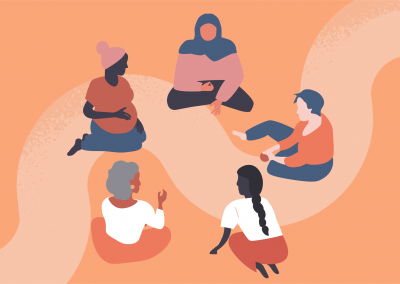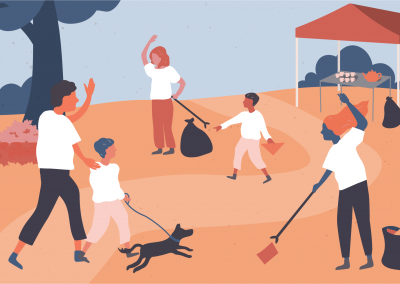NHS Palliative Care
Pursuing results through relationships in a large, complex system
‘The people I meet at the hospice will say: It’s the first time someone’s listened to me as a person,’ says Saskie Dorman, a Palliative Care Consultant in the South West of England. ‘I find that so sad. It shouldn’t wait until the last three weeks of someone’s life until someone can feel they’re seen as a person.’
Sarah Yardley, a Palliative Care Consultant in London, makes a similar point: ‘People are often pushed to communicate by transmitting information and hoping it’s received, or repeatedly checking and chasing to see if it’s been received, when actually real-time dialogue would be so much better. There are so many situations where you can’t help thinking: If only there’d been an actual conversation.’
Relationships at scale
Sarah and Saskie both work in the National Health Service, a vast, complex system that is under considerable strain: squeezed finances, staff shortages, growing waiting lists.
What might it mean to put relationships first in a sprawling system like the NHS, made up of so many different organisations, each with their own particular culture? Is it possible to prioritise relationships in such an over-stretched institution? How might relational work look and feel at this scale?
It might be tempting to think that a huge multifaceted entity like the NHS simply isn’t suited to relational ways of working, that only strict processes and protocols could possibly allow it to function. But although scale and complexity might add challenges to relational work, Sarah cautions against thinking of the healthcare system as something unavoidably rigid and remote: ‘Systems don’t appear out of thin air,’ she says. ‘People create the system, and people can make or break it.’ The NHS is made up of people and the relationships between them.
Small acts of resistance
In recent decades, says Sarah, there has been an emphasis on ‘trying to create systems that don’t rely on people knowing each other’, deliberately designing relationships out. ‘If you strip away to a functional, instrumental way of doing things, what’s lost?’ Sarah asks. ‘Stuff won’t happen as it should without them.’
Many healthcare staff agree and attempt to prioritise relationships, even as the space to do so shrinks around them.
‘My working theory of the current situation,’ says Sarah, ‘is that there are quite a lot of people engaging in “small acts of resistance”: individuals or teams who refuse to stop working relationally. They’re doing work to mitigate the fact that the structural stuff doesn’t work, perhaps can’t work.’ Rather than their acts of resistance being perceived as such, however, their additional efforts are simply reabsorbed by the system, coded as acts of generosity: ‘A lot of that gets phrased as going the extra mile,’ Sarah says.
Sarah points out how strange it is that putting relationships at the heart of healthcare has come to seem radical. ‘I don’t think it should be radical,’ she says. ‘It sort of disappoints me if it is.’ And yet, in the NHS, ‘professionals feel they need permission to work relationally.’ Prioritising relationships has become counter-cultural.
To be relational is to be responsive to the person in front of you, not tied to a rigid process.
But, Sarah says, despite rhetoric in the NHS about moving away from a blame culture, ‘when something goes wrong, we create more rules: it’s like the box you’re working in gets smaller and smaller and smaller.’
The stuff that happens between people
Sarah and Saskie are examples of healthcare professionals committed to working relationally and taking structured, deliberate action to demonstrate the impact and importance of relationships in healthcare. It is perhaps no accident that they both work in Palliative Care, a field of medicine where dialogue and relational working are more prevalent.
Palliative Care involves providing care – physical, social, psychological and spiritual – for people with a serious illness that will not respond to curative treatment. It is ‘about understanding what matters to people,’ says Saskie, ‘helping them and those around them to understand and anticipate what may happen in the time they have left.’ It is not always about end-of-life care, but this is a significant dimension of the work.
Sarah spends part of her time working in hospital and the rest researching ‘the role of relationships and connections in healthcare – the stuff that actually happens between people – at all levels, in all directions, across different groups and different professions.’
‘I like the intensity of deep and meaningful conversations and connections,’ says Sarah. ‘Those traits suit palliative care: our work is about in-depth work with a smaller volume of people.’
The gap between intentions and outcomes
Palliative Care is a valuable place to examine relationships in healthcare because it’s an area where the consequences of rigid, non-relational approaches can be particularly stark, at the personal and systemic level. For individuals, it can mean discomfort and distress. For the system, it can mean increased costs, workload and strain.
‘Of all our lifetime healthcare costs,’ says Saskie, ‘a significant proportion is spent in the last year of our lives.’ It is a crucial, consequential phase for many reasons. And ‘for each person,’ says Sarah, ‘there is only one chance to get it right.’
Based at an NHS hospice, Saskie integrates relational practice into her work and has been testing new ways of doing this with colleagues locally and across the South West of England.
A contradiction at the heart of the current system is that staff have very good intentions, but those good intentions don’t always translate to good outcomes. People and families often have experiences that no one would wish for towards the end of life.
The deprioritisation of relational work in the NHS is, in part, a product of structural issues, like ’the way care is contracted and commissioned,’ says Saskie, ‘which tends to make it focused on ticking the box, rather than meeting people where they are. Regulation is another significant factor. Fear of judgement can lead organisations and individuals to put policies and protocols ahead of doing what really matters.’
Ticking boxes
Saskie gives the example of Barbara, a 90-year-old woman, who was in hospital, nearing the end of her life. Procedure dictated that a photo should be taken of a pressure sore on her bottom, so she was hoisted, semi-conscious from her bed. Within two hours, Barbara had died.
A relational rather than formulaic approach might have meant Barbara having ‘the chance to stay at home on the last day of her life,’ Saskie says, ‘and having her husband with her when she died. It might have meant being able to rest in comfort rather than being hoisted to have a photo of her pressure sore – recognising that her dignity and comfort were more important than following the standard protocol.’
As well as questioning the suitability of that decision, Saskie asks this disarming question: ‘When looking through healthcare records, why is it more normal to see photos of pressure ulcers on backsides than photos of faces? It was really easy to find Barbara’s blood pressure and test results. It took us a lot longer to get an idea of who she was.’
‘It was an epiphany,’ says Saskie, ‘a painful one. I thought: I can’t carry on just doing what I’m doing in this system.’
Saskie tells other stories about people she has cared for in the hospice who have experienced exhausting journeys through the health service, struggling to be heard, having the same conversation on loop with different professionals.
‘Those encounters made me think: just providing a beautiful last few days is not going to change this tick-boxy, process-driven healthcare,’ says Saskie. ‘It doesn’t change the fact that people go back and forth for months and end up in these distressing situations. The transactional, protocol-driven approach doesn’t really work: it’s expensive and it makes people sick.’
Sarah echoes Saskie’s conclusion:
Instead of trying to create systems that don’t rely on people knowing each other, our energies should be focused on creating systems that facilitate relational working.
A longer conversation
As an everyday example of the difference a relational approach can make, Sarah describes an interaction with someone who refused to be discharged from hospital.
‘In hospital one day I was asked to go to see a man, a patient,’ she says. ‘He was there with his son. The message said that we’d done everything we could in the hospital; it was time for him to go home, but he didn’t want to leave.’
‘I walked up and his son said: Are you going to be another person who says he has to go home? So I said: Why don’t you tell me what the two of you want to talk about?’’
‘Then this story unfolds. Basically, the man has a medical problem that means that, for the last three months, he’s been told he could have a major bleed and die at any moment. But now the hospital teams have got to the point where they have no more interventional treatment to offer, so they’ve said it’s time to go home. Perfectly understandably, though, he’s saying: I’d like to spend the rest of my life in hospital, because you said I could bleed to death at any moment. So we’ve created the problem, fixing this idea in his mind then asking him to leave.’
‘Just by being there and listening and giving them the power, this all came out, in the way it hadn’t in the routine process of: Now you’ve got to leave the hospital. We went on to have a much longer conversation, talking about quality of life and what would happen in hospital if he had a bleed and how he could be looked after at home and how we could set things up so that, you know, he didn’t have a painful, terrible death. And in the end, we worked something out together. The son and his Dad had a better understanding of why people were saying what they were saying and the difference between hospital and home. We reached a position where we could move forwards and decisions could be made.’
‘His son said to me at the end: I hope you didn’t think I was being too pushy or aggressive. And I said: This is your Dad. Your role is to advocate for him, to fight for what he wants. My role is to be the doctor. You and I have to work within the parameters of our roles, but we can do it in a way that recognises each other as people and that this system is far from perfect.’
Investing to save later
A criticism of Sarah’s story might be that healthcare professionals cannot always afford to take an hour to have an extended conversation. Sarah points out, though, that this can be a wrong-headed way to think about time in a large healthcare system. ‘There’d been at least six ten-minute conversations already,’ she says. ‘If we viewed time collectively in healthcare, rather than individually, we’d see that taking more time now means less time later.’
Everyone trying to do things as quickly as possible can lead to more time being spent overall. ‘The more individually you see yourself as a resource, the more warped that gets,’ Sarah says.
Sarah talks about how this approach creates ‘part-system efficiency’ but not ‘whole-system effectiveness’. Everyone cuts and squeezes where they can, making their piece of the process seem more efficient, but the net effect is to increase demand on the system as a whole.
Prioritising relationships, Sarah suggests, involves healthcare professionals ‘investing to save later’, asking themselves: ‘Are we investing time to get things right first time?’’ To do this, professionals ’need to know they won’t be penalised for not following all the “rules” when the right thing to do is different to the norm’.
‘Within policy rhetoric, there are shifts in the language,’ says Sarah, ‘from patient-centred care to person-centred care. And there’s a growing emphasis on individualised or personalised care. But, at the same time, professionals are still judged on providing equality, rather than equity in healthcare.’
Equity is not created through structural standardisation. Instead we should be aiming for equality of access to relational working and care so everyone has the same opportunities to get what they need.
Measuring preventative benefits
What was the value of Sarah’s relational interaction with this father and son? ‘It’s a lot easier to measure cost than value,’ says Sarah. ‘I can say that the interaction felt good, as can the patient and his son. We can say he left the hospital, which is what everyone wanted. But the actual value still feels intangible.’
‘With a lot of relational working,’ Sarah continues, ‘people come back and say: How will we measure that it’s a good use of resource? And it’s tricky. There’s something seductive about costing everything. It can be good for some things, but it’s a bit mechanical, a bit robotic.’
It’s difficult to measure time not wasted, money not spent, people not feeling disempowered, problems not recurring, issues not getting worse – even if these might be precisely the outcomes we want.
One way of framing these outcomes would be to think of them as the ‘preventative benefits’ of relationships. ‘We’re very comfortable with the idea of preventative treatment for physical things, like medicines to stop things worsening or recurring,’ says Sarah. ‘We’re not at all good at prevention when it comes to the more human elements of healthcare, like talking with someone in a healthcare setting.’
Results through relationships
Working with colleagues in the South West, Saskie developed an initiative called Results Through Relationships to improve the quality of end-of-life care.
‘If the opportunity had arisen three years earlier,’ Saskie says, ‘it would have been more of a traditional, standard project: deciding on an evidence-based intervention to improve care, implementing it and evaluating the outcomes. Instead we thought: Let’s look at things differently and really think about what this means to people.’
As it is, Results Through Relationships ‘recognises that healthy outcomes are created collaboratively’, says Saskie.
None of us is an island. In any network, the nature and strength of relationships between individuals is at least as important as the nature of the individuals themselves. Enabling effective care becomes less about implementing interventions, and more about creating conditions in which mutuality and collaborative learning can thrive.
The ‘results’ part of the title is important – and runs counter to the idea that relationships are soft or supplementary. ‘This isn’t about teams getting together, having a nice time and eating cake,’ says Saskie. ‘It’s doing something meaningful, purposeful and effective.’ People focused on results like finances and hospital admissions are more likely to be won over, she suggests, if they can see that ‘healthy relationships enable those results to happen’.
Doing what matters
The essence of Results Through Relationships is ‘doing what matters’ rather than ‘doing what’s expected’. Saskie describes the contrast bluntly:
Care that focuses on tasks – doing what’s expected rather than what matters – costs more overall and tends towards outcomes that no one wants.
The concept sounds simple and the advice for practitioners can be summarised as: ‘Ask what matters, listen to what matters and do what matters.’ But while this may sound straightforward, the implications for healthcare professionals are enormous. Doing what matters can involve significant shifts in perspective, such as considering people in context rather than treating them as isolated individuals, highlighting what matters and what’s strong, not just what’s wrong, and anticipating rather than reacting to a crisis.
Through these and other shifts, a richer, more accurate picture of people’s hopes and needs can emerge, providing a better foundation to make decisions. Out of ‘fog’ and ‘friction’ comes ‘fellowship’ and a ‘focus on what matters’. ‘Often,’ says Saskie, ‘what matters to people can be summarised relatively simply.’
Bespoke by default
Fundamentally, taking a relational approach in a complex system like the NHS requires healthcare professionals to embrace the fact that they’re dealing with individuals with different needs, desires and circumstances, which may require different responses. A relational response can embrace the variety of real-life situations.
Inspired by Mark Smith, Director of Public Service Reform at Gateshead Council, Saskie suggests we take a ‘bespoke-by-default’ approach in healthcare rather than inventing ‘protocols to tell us what to do in every circumstance’.
This does not mean creating an unpredictable free-for-all. Rather it means expecting healthcare professionals to adapt their approach from one situation to the next and designing the surrounding structures to enable this. Being bespoke-by-default is another form of consistency: being consistently responsive rather than consistently rigid.
This can be satisfying for staff, who may feel the relief and excitement of suddenly looking through the right end of the telescope. But it can also be uncomfortable, requiring them to let go of entrenched habits and longstanding professional identities. ‘Challenging long standing worldviews can feel threatening or scary,’ says Saskie.
Taking a bespoke-by-default approach is likely to involve trusting, training and treating colleagues differently, so that they are equipped to listen, form relationships and use their professional judgement to make the best decision with individuals, families and colleagues first time.
The benefits of this approach could be substantial: more effective, streamlined healthcare for individuals; more effective support and involvement from families; richer, more rewarding work for staff; stronger relationships and less burnout across teams; and lower pressure on the system as a whole.
Weighing risks
A bespoke-by-default approach also involves accepting that people will weigh risks differently.
‘Prioritising the needs and choices of individuals or groups can create tensions with structural safety standards,’ says Sarah. And yet, these standards themselves are skewed, tending to weigh ‘techno-clinical’ risks far more highly than ‘psychological, social or spiritual’ risks. Even the language of risk can cloud judgement in some situations. ‘What would happen,’ asks Sarah, ‘if we didn’t refer to choices as risks?’
Giving people more agency enables them to weigh their priorities holistically and make the choices that matter most to them.
Changing the everyday stuff
What would it take to put relationships first in the NHS?
Both Sarah and Saskie mention small things healthcare professionals can do immediately to work more relationally.
Mostly, when we talk about relational work, we’re talking about different speech and action, not more. It doesn’t have to take longer to behave relationally. It doesn’t take longer to say What do I need to know in order to best help you? than to say What’s wrong, why have you come here today?
‘As an extreme example, emergency departments deal with large volumes of people and often focus on crisis management’, says Sarah. ‘But you can still work relationally in A&E if you’ve been helped to develop the right skills and are willing to try behaving differently.’
‘There are other relational things you can do that don’t take any time at all,’ she continues, ‘like learning your colleagues’ names, viewing everyone you interact with as a colleague. My husband’s a surgeon. He deals with a lot of emergency situations, but he still bothers to read and remember the theatre cleaner’s name badge and say hello to them in the morning.’
Saskie echoes this view. ‘It’s about using the times and spaces we already have, changing some of the everyday stuff,’ she says. ‘Every NHS organisation has lots of meetings – it’s about repurposing them, showing up in different ways. If enough of us do that, it can help to shift the culture.’
‘Even sending emails,’ she continues, ‘it’s thinking of the person on the other end of it, trying to retain some humanity. And trying not to use email as much as conversations.’
Although wider conditions have a big impact on the scope for relational work, Saskie is keen to emphasise that individuals within the healthcare system have agency.
‘Everyone’s got some power and agency to create behavioural and cultural change,’ she says. ‘When we talk about the whole system needing to change that can feel overwhelming and disempowering. We might as well not even try! But focusing on what we can do enables change to start. And since behaviour is reciprocal, small changes can have profound ripple effects.’
Rolling in
Although few in healthcare are anti-relationships in principle, there can be resistance to prioritising them in practice. ‘Often when you’re trying to do something,’ says Sarah, ‘people say: You don’t understand, that’s not how it works in the real world.’
For this reason, Sarah researches, and participates in, relational practice on the ground. ‘I want to say: Let’s look at how it works in the real world and then go back the other way.’
That’s exactly what Saskie and her colleagues are doing in her locality: gradually changing practice and demonstrating the impact of relational work. But how can this kind of ground-up change spread and scale across a large system?
Rather than a ‘roll out’, Saskie proposes a ‘roll in’, in which other professionals proactively try a new practice, and adapt it for their context, rather than having it imposed on them from above. ‘You can’t just say: This is how you do it, just do this,’ Saskie says. ‘Context really matters.’ Through this form of careful horizontal transfer and collaborative learning, relational approaches can ‘become normal practice in more places’.
Saskie is part of an End of Life Network, hosted by NHS England – South West, which shares and spreads relational ways of working. The network has grown from 30 to 600 practitioners over the last four years.
There’s still a long way to go, it’s not all sorted. But it definitely feels like there’s momentum, a shift, a groundswell of this way of working.
Reflection questions
Digging deeper
- What does this story suggest about the distinct challenges of relational working in large organisations or systems?
- How might spending time on relationships actually save time and money in this example?
- How might a ‘roll in’, rather than ‘roll out’, support relational practice to scale here?
Applying the learning
-
- How could focusing on ‘what matters’ rather than ‘what’s expected’ affect relational work in your context?
- How might a bespoke-by-default approach manifest in your context? s
More stories
The Relationships Map
The Relationships Map is a space for anyone who believes in the importance of relationships to find one another, share ideas and resources, feel part of something bigger, and realise more than the sum of our parts.









